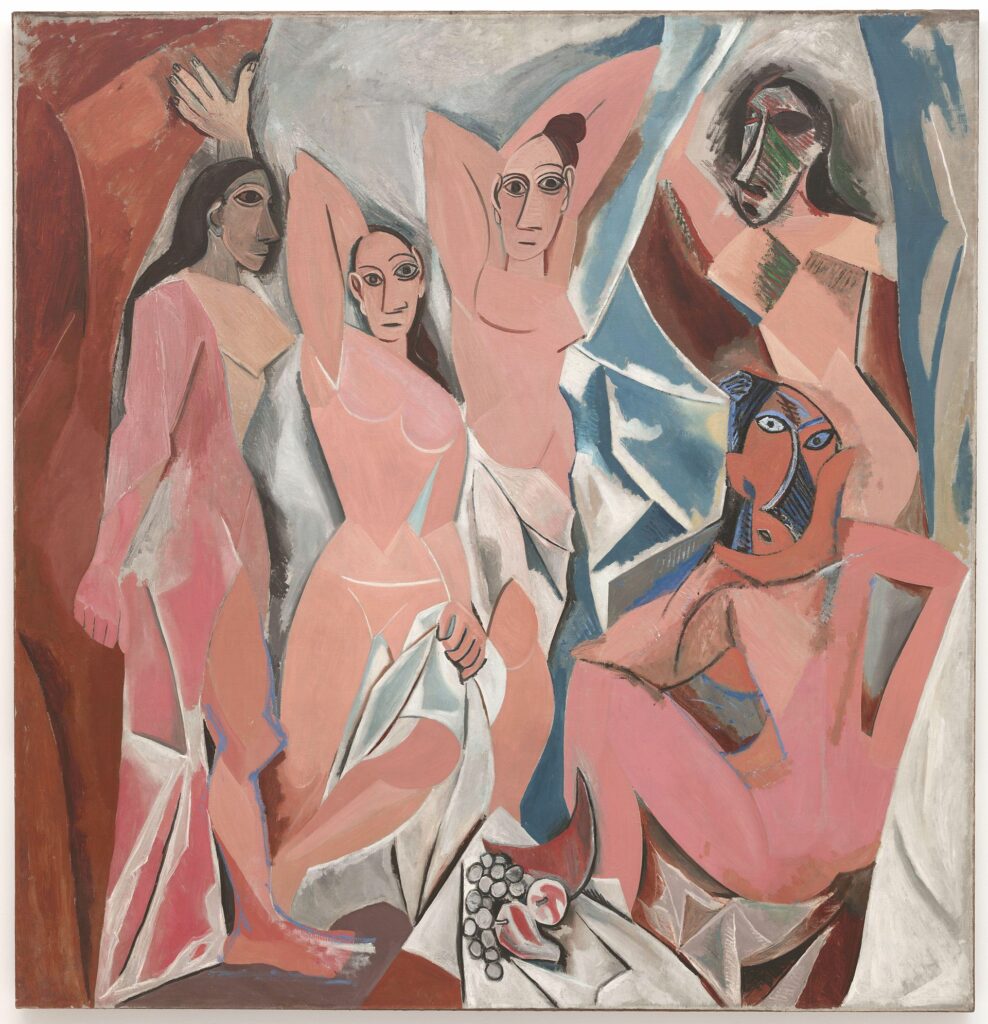Miniature Paintings
- The word ‘miniature’ is derived from the Latin word ‘Minium’, which means red lead paint. This paint was often used in the illuminated manuscripts during the Renaissance period.
- It is generally confused with the word minimum, which would mean that they were small in size. Miniatures are small and detailed paintings.
- Miniature Paintings were complex, colorful , and small in size, with delicate brushwork. The history of Indian Miniature Paintings has started in 6th – 7th century. Miniature Painting was drawn to convey reality.
- The different schools of Indian miniatures are the Pala Odisha, Jain, Mughal, Rajasthani etc.
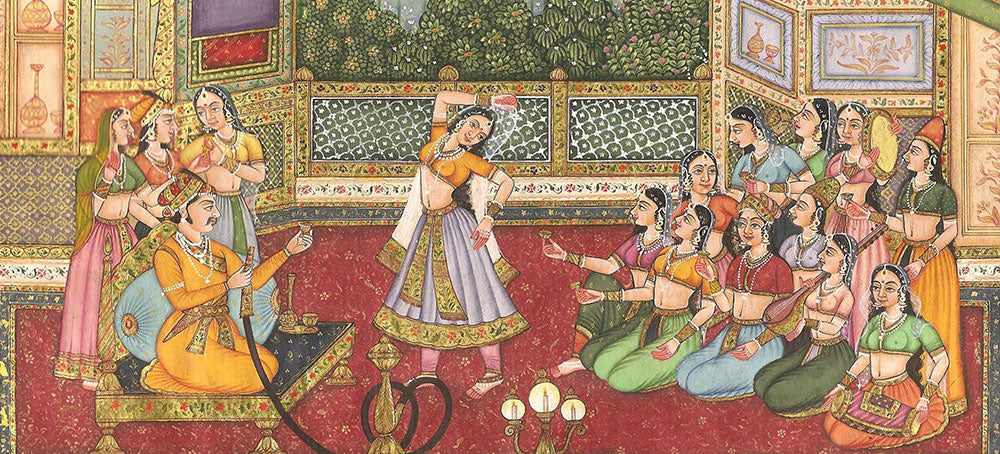
Techniques of Miniature Paintings
- Paintings were executed in the traditional tempera technique. Several preconditions need to be fulfilled for making Miniature paintings.
- The painting shouldn’t be larger than 25 square inch.
- The subject of the painting should be painted in not more than 1/6th of the actual size.
- In these paintings there are very few human characters with visible front face. Most of the human characters are seen with side profile.
- Big eyes, pointed nose and slim waist are the features of these paintings. The skin colours of human being are Brown and fair. The skin colour of the Lord Krishna is Blue.
- The colour of the hair and eyes is black. Women characters have long hair. Men and women wear the traditional Indian dress, slippers and shoes. Men wear turbans on their head.
- Mostly Natural colours have been used in these paintings. Black, red, white, brown, blue, and yellow colours are used to decorate the paintings.
Early Miniatures
- As discussed earlier, miniature paintings were small paintings with minute details. They were often painted for either books or albums, on perishable material including paper, palm leaves and cloth.
- Developed almost as a reaction to the enormous wall paintings, the art of miniature painting developed between 8th and 12th centuries. This kind of painting can be attributed to the eastern and western regions.
- Two prominent schools are:
- Pala School of Art
- Apabhramsa School of Art
Pala School
- The Pala School of painting produced some of the earliest examples of miniature painting in India. This school of painting flourished during 8th to 12th century.
- It was executed under the Palas of Bengal in the eastern India. This period witnessed the last great phase of Buddhism and of the Buddhist art in India.
- The Pala painting is characterised by sinuous line and subdued tones of colour. It is a naturalistic style which resembles the ideal forms of contemporary bronze and stone sculpture, and reflects some feeling of the classical art of Ajanta.
- Here mostly the Palm leaf and Paper were used. There are lonely single figures in the paintings and one rarely finds group paintings.
- They have simple compositions and were patronised by some of those rulers who promoted Buddhism. The proponents of the Vajrayana School of Buddhism also used and patronised these paintings. The prominent painters were Dhimman and Vitapala.
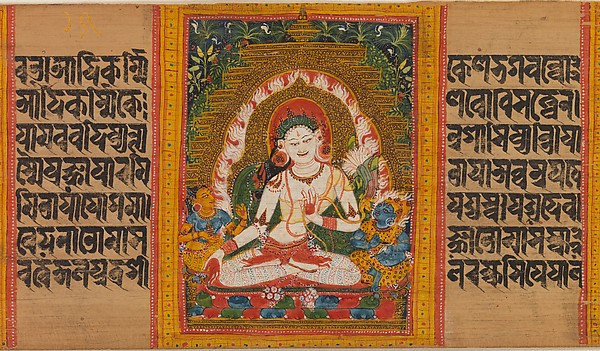
Apabhramsa School of Art
- This school is also known as western school of art. This school traces its origin to Gujarat and Mewar region in Rajasthan.
- It is the counter part of Pala School which developed in Western India (Rajasthan and Gujarat). This school is divided in two phases,
- Illustrations made on palm leaf
- Illustrations made on paper
- The motivating force for the artistic activity in Western India was Jainism. The most common themes of these paintings were Jain and in the later period the Vaishanava School appropriated them too. They brought in the concept of Gita Govinda and secular love into these paintings that were otherwise dominated by the Jain iconography.
- From about 1100 to 1400 CE, palm-leaf was used for the manuscripts and later on paper was introduced for the purpose.
- Even though the paintings were made as illustrations for books, they did not develop a different style but were mural paintings in a reduced dimension.
- The colours used in the paintings had symbolic meaning and they usually used red, yellow and ochre. In the later phase, they used bright and gold colours.
- Unique feature:
- the features of the human figures depicted in the paintings have fishshaped bulging eyes, a pointed nose and a double chin.
- They tried to begin the trend to make angular faces in the third and fourth profile. The figures are usually stiff and even the ornamentation is carefully done.
- The female figurines have enlarged hips and breasts. The animal and bird figurines in the paintings are represented as toys.
- The most famous example is of Kalpasutra and the Kalakacharya Katha from 15th century.
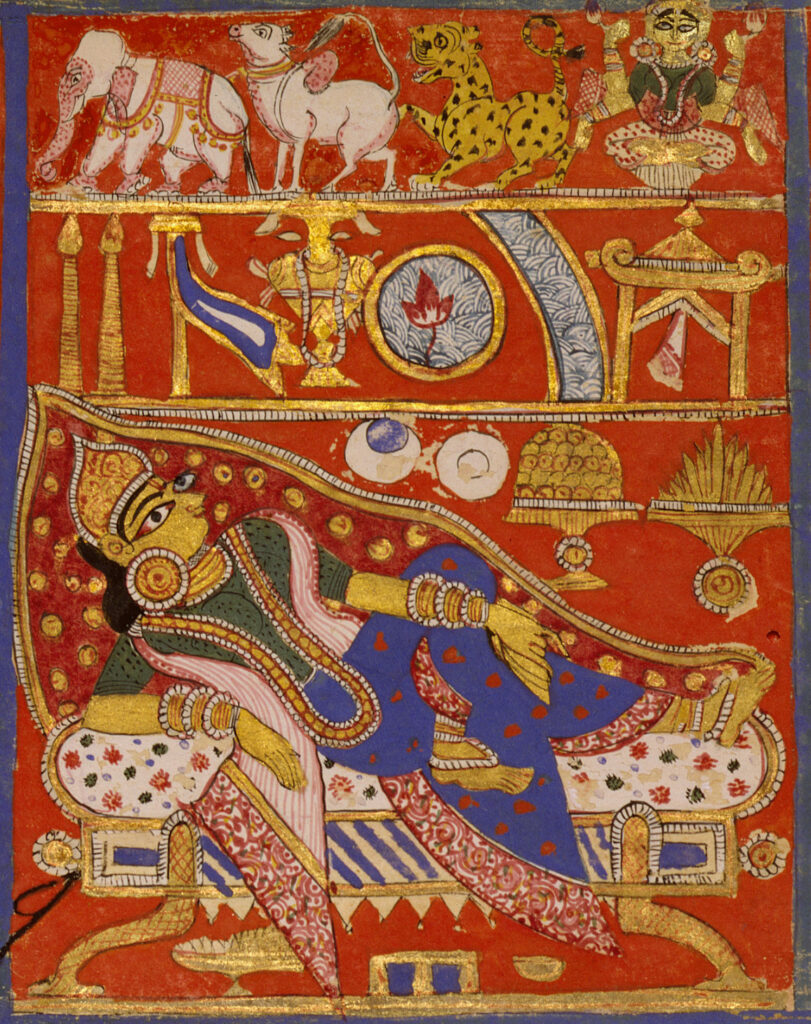
Transition Period Miniature
- The coming of the Muslims in the Indian sub-continent was a harbinger of change and brought forth a cultural renaissance in the 14th century.
- One should not say that the Islamic styles took over as the traditional styles of paintings survived in the Western Indian courts and a cultural synthesis took place. In the Southern States of Vijayanagara, a different style was emerging that was closer to the Deccan style of painting.
- The colours were applied in a flat manner and the dress and human outlines are demarcated in black. The view of the face forms a three quarter angle and gives a detached appearance. The landscapes are full of trees, rocks and other designs that do not try to replicate the natural appearance of the subject.
Miniature Art during Delhi Sultanate
- The Delhi Sultanate developed an Indo-Persian style of painting that drew heavily from schools in Iran and Jain paintings.
- Most Sultanate painting dates between about 1450 and 1550, and the centers of production seem to be primarily Mandu in central India and Jaunpur in eastern India, with some work being done in the Delhi region and in Gujarat in western India.
- Features of Delhi Sultanate paintings that are based on Indian traditions include groups of people standing in rows and identical poses, narrow bands of decoration running across the width of the painting, and bright and unusual colors.
- A remarkable manuscript called the Nimat Nama, painted in Mandu is a book of recipes (during the reign of Nasir Shah who ruled over Mandu), which shows the sultan surrounded by attendants preparing foods, medicines, and aphrodisiacs. The painters of the pictures were Indian, but they drew heavily from Shirazi models, with much use of thick green swards, pastel background colors, and provincial Persian figural types.
- Apart from this, another style called Lodi Khuladar was also prevalent during this period that was followed in many of the Sultanate dominated regions between Delhi and Jaunpur.
- Later, three major styles emerged that dominated the medieval landscape – Mughal, Rajput and Deccan. They borrowed from the sultanate precedents but developed their own individuality.
- The paintings of the Delhi Sultanate represent a period of inventiveness that set the stage for the development of the Mughal and Rajput schools of art, which thrived from the 16th to the 19th centuries.
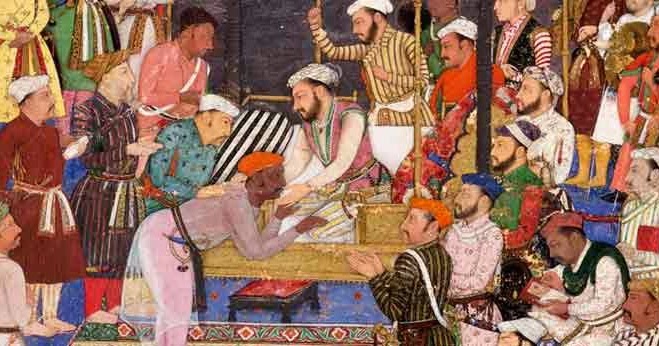
Mughal Era Miniature Painting
- The Mughal emperors introduced their own style of painting with Persian inspiration and added new themes, colours and forms. Court scenes were depicted in grandeur. The background was usually hilly landscapes. Flowers and animals were also vastly depicted.
- The focus shifted from depicting the god to glorifying the ruler and showing his life. They focused on hunting scenes, historical events and other court related paintings.
- The Mughal paintings are characterized by their subtleness and naturalism. They are considered unique because of the use of brilliant colors.
- They brought the technique of foreshortening to the Indian painter’s repertoire. Under this technique, “objects were drawn in a way that they look closer and smaller than they really are.”
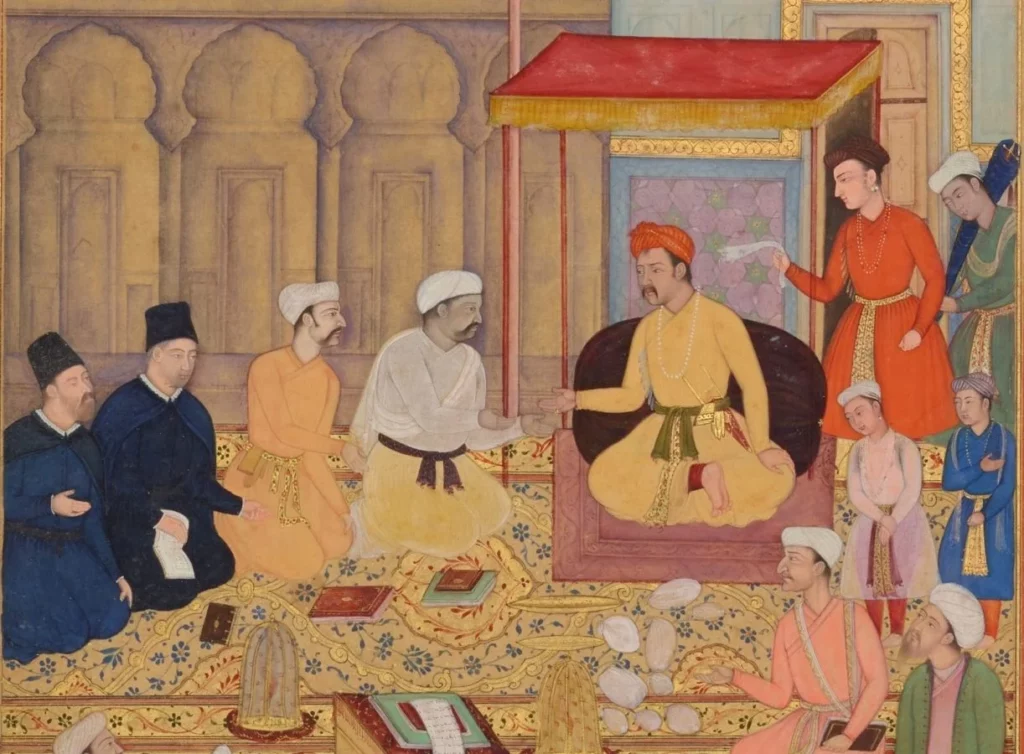
Early Mughal Painters
- Babur established the Mughal dynasty after fighting a series of wars. He did not have much time to commission paintings, but he is said to have patronised the Persian artist Bihzad who made some illustrations of the Mughal family tree.
- Humayun who was a great patron of arts came to the throne at a young age. He was interested in paintings and building beautiful monuments, but his atelier was disrupted when he lost the throne to Sher Shah Suri and was exiled to Persia.
- While he was at Shah Tahmasp’s court in Persia, he acquired the services of two main painters called Abdus Samad and Mir Sayyid Ali who came back with him after he won his throne back and established the Mughal dynasty in India.
- These artists were responsible for bringing Persian influence in the Mughal paintings and created many successful illustrated albums.
- During Akbar’s reign, they created an illustrated manuscript called Tutinama (Tales of a Parrot).
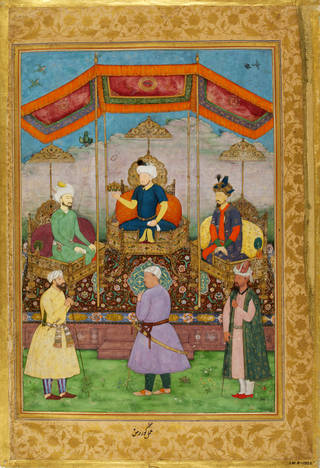
Akbar
- Akbar was responsible for establishment of an entire department devoted to the paintings and scribing of his documents. He established a formal artistic studio called Tasvir Khana where the artists were hired on salary and they developed their own styles.
- Akbar looked upon paintings as a means of study and amusement. He believed that a painting could show the demeanor of the subject and regularly awarded painters who created lifelike images.
- Akbar also recognised the beauty of those Indian artists who had worked for previous rulers and invited them to work in his tasvir khana. Hence, the ‘Indian influence’ started in the Mughal paintings. The defining features of paintings in Akbar’s period are the use of 3 dimensional figures and the continued use of foreshortening.
- Furthermore, the artists encouraged the use of calligraphy in the paintings. One of the distinguishing features of this period was the transformation of popular art to the court art, i.e. the artist was more focused on depicting the scenes of court life than the life of the masses.
- Famous painters of this period include: Daswanth, Basawan and Kesu. Prominent illustrated manuscripts during Akbar’s reign are Tutinama, Hamzanama, Anvar-i-Suhaili and Gulistan of Sadi.
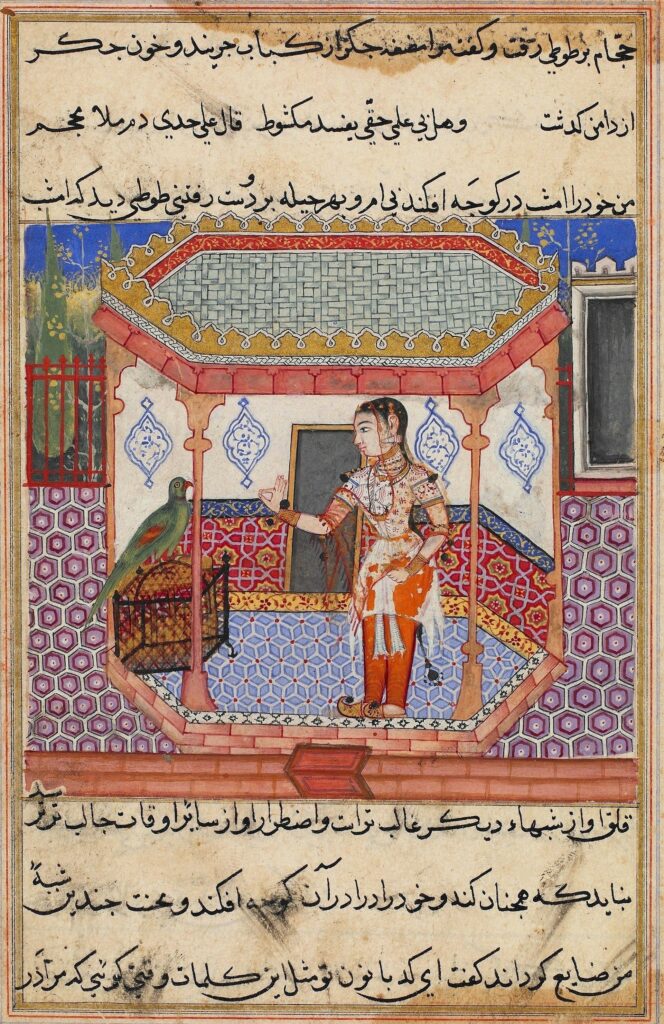
Jahangir
- Mughal paintings reached its zenith during the period of Jahangir.
- He was a naturalist and preferred portraits of flora and fauna. The paintings of birds and animals in this era are timeless world classics.
- He shifted from illustrated manuscripts to album and emphasised on bringing naturalism to portrait (individual) painting. One of the unique trends that developed in this period was of decorated margins around the paintings that were sometimes as elaborate as the paintings themselves.
- Jahangir was himself considered to be a good artist and he had his own private workshop although no major work by him survives. His atelier mostly created miniature paintings and the most famous amongst them were the naturalistic paintings of the Zebra, the turkey and the cock.
- One of the most famous artist from his period was Ustad Mansoor who was an expert in drawing the features of the most complex faces. An animal fable called Ayar-i-Danish (Touchstone of Knowledge) was illustrated during his reign.
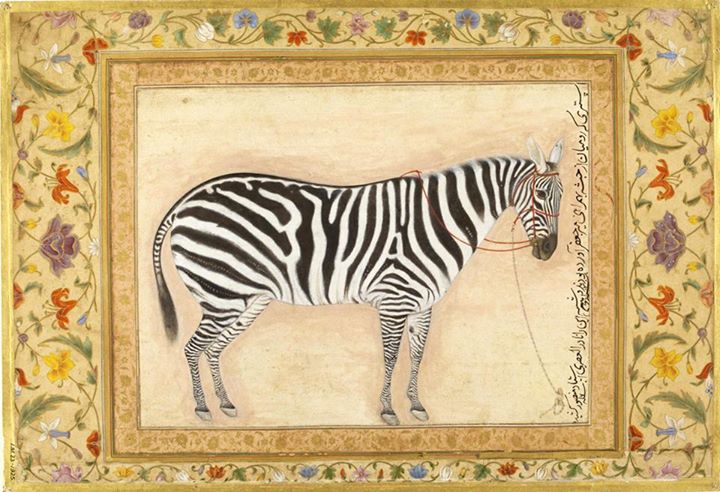
Shah Jahan
- The tenor of the Mughal paintings changed rapidly in the period of Shah Jahan. Unlike his father and grandfather who liked naturalistic depictions, Shah Jahan liked creating artificial elements in the paintings.
- It is said that he tried to reduce the liveliness of the paintings and bring in unnatural stillness as he was inspired by the European influence.
- He eschewed the use of charcoal to draw and encouraged the artists to draw and sketch using a pencil. He also ordered to increase the use of gold and silver in the paintings. He also liked brighter colour palettes as compared to his predecessors.
- Hence, we can say that the Mughal atelier was enlarged during his reign but changed a lot in style and technique.
- Romantic in temperament, Shahjahan, little liked violence and ugliness.
- Portraits and random themes like durbar scenes, processions, festivals, scenes of outings etc were referred.
Aurangzeb
- Aurangzeb did not encouraged Mughal paintings.
- Painters of the Mughal court moved to Rajasthan and other kingdoms. They carried with them the Mughal art-style which was amalgamated with the taste and likings of their new patrons and local elements.
- This amalgamation created a new art-style widely known as Provincial Mughal. Awadh became the foremost seat of the Provincial Mughal art.
Rajput Paintings (Regional Schools of Painting)
- The Rajput paintings flourished under the patronage of the Hindu Rajput rulers of Rajputana and Punjab Himalayas during the period 1500 CE to the middle of the 19th century.
- The art of painting in Central India, Rajasthani and the Pahari region etc. is deeply rooted in the Indian traditions, taking inspiration from Indian epics, religious texts like the Puranas, Indian folk-lore and works on musical themes.
- The themes from the Ramayana, the Mahabharata, the Bhagavata, the Siva Purana, Gita Govinda of Jayadeva etc. provided a very rich field to the painter who with his artistic skill and devotion made a significant contribution to the development of Indian painting.
- The Rajput paintings can be put under two broad groups:
- Rajasthani School of Painting
- Pahari School of Painting (17th-19th century)
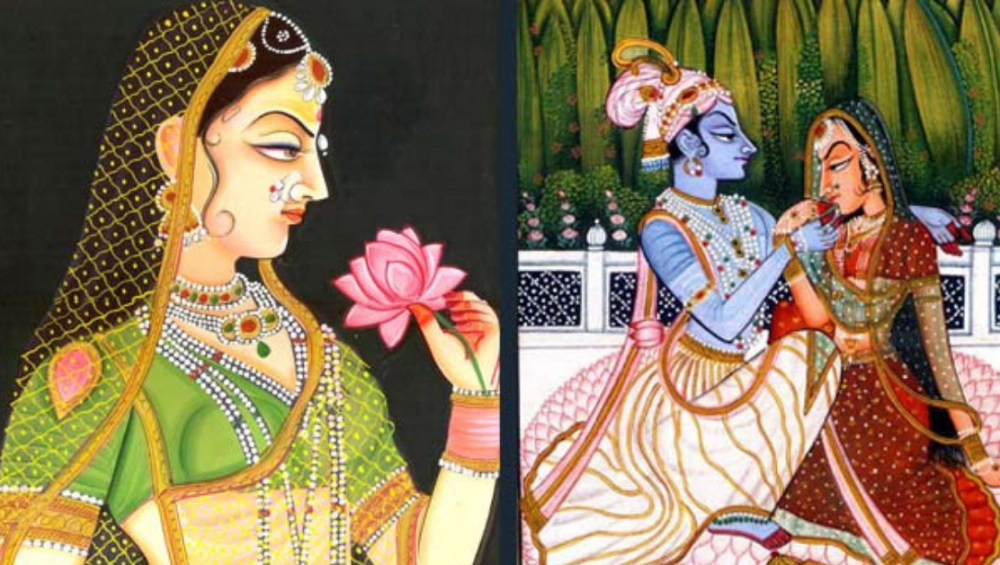
Rajasthani School of Painting
- Rajasthani paintings are those works that have been executed in Rajputana, from Bikaner to the border of Gujarat and from Jodhpur to Gwalior and Ujjain.
- The themes of the paintings were mostly religious and love subjects, based on Lord Rama and Lord Krishna. Court scenes were depicted as also royal portraits.
- Bold outlines and brilliant colours are characteristic of the Rajasthani paintings.
- The story of Padmavati, penned by the poet Malik Muhammad Jaisi, provided a common theme to the Rajput paintings. Illustrations of Mahabharata, Bana Bhatta’s Kadambari, the Panchatantra were painted.
- The Rajput painting developed individual styles in Bundi, Kota, Jaipur, Mewar and Kishangarh.
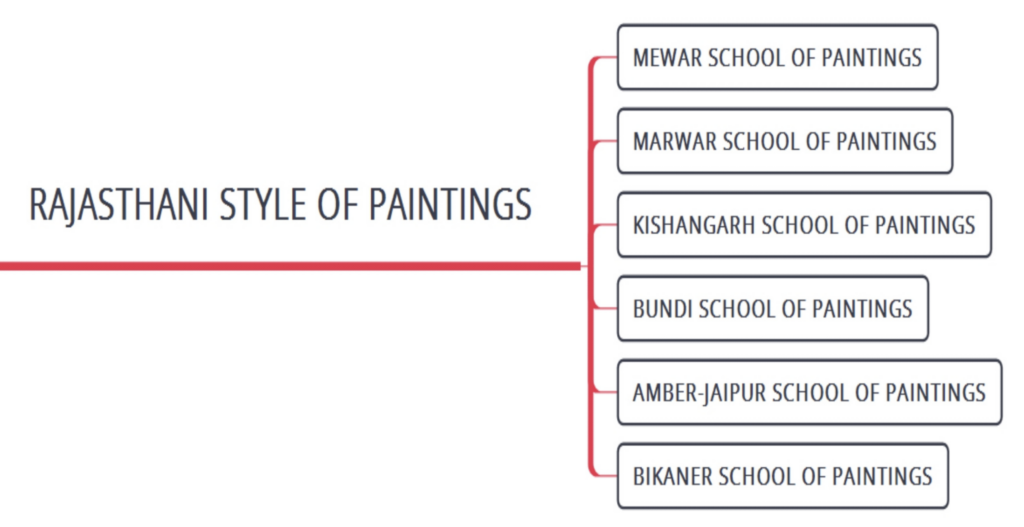
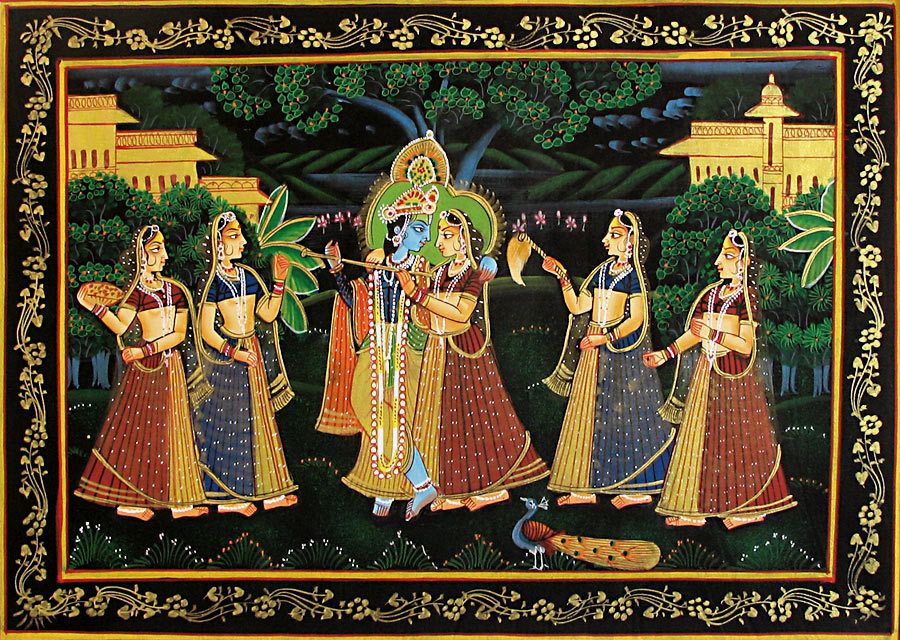
Mewar School of Painting
- The kingdom of Mewar resisted Mughal suzerainty for the longest time, eventually agreeing to Mughal power in the reign of Shah Jahan.
- Mewar passed through a turbulent period of political unrest, yet, the Rajput kings went on patronising the art and in fact helped it to grow up into distinct style.
- The real beginning of a polished style of Mewar painting started in 1571 CE. By that time, it fully replaced the ‘Apabhransa’. One immediate reason of development of this school was that a large number of artists migrated from Mandu to Mewar after Baj Bahadur, the ruler of Mandu was defeated by Mughals in 1570.
- If one looks at the early Mewar painting, it is realised that it was dominated by the extraordinary painter of 17th century, Sahibdin. This period of Mewari painting focuses on Sahibdin’s depiction of literary texts – the Ragamala, the Ramayana and the Bhagavata Purana.
- The Ragamala painted in 1605 A.D. is the earliest example of series of Mewar painting.
- Ragmala paintings are a distinct feature of Rajput miniature paintings. These are pictorial representation of Indian Ragas and Raginis. The mode and time of Raga is expressed through brilliant colours and colourfully dressed Nayak and Nayikas. They are usually dressed in contemporary royal fashion.
- After Sahibdin’s death, the style of Mewari paintings changed. Most of the paintings depicted the life at court in Mewar. The unique point of this period is the extraordinary ‘tamasha’ paintings that show court ceremonial and city views in unprecedented detail.
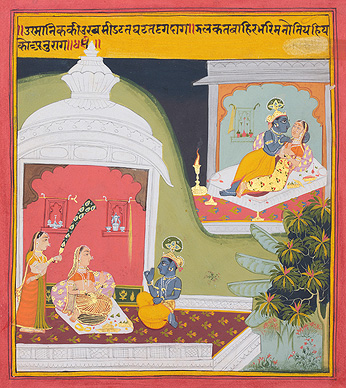

Kishangarh School of Painting
- It developed under the patronage of Raja Savant Singh (1748-1757 CE)
- Bani Thani painting belongs to this school.
- Unfortunately only a small number of Kishengarh miniatures are available. Most of them are believed to have been done by the master painter Nihal Chand who, in his works, has been able to create visual images of his master’s lyrical compositions. The artist has executed types of human figures, delicately drawn, with slender bodies and uptilted eyes.
- It is sometimes argued that the women in ‘bani thani’ is said to resemble the character of Radha. She has a distinctive profile and has lotus like elongated eyes, thin lips and a pointed chin. Her ‘odhni’ or headgear defines her side profile. This became the unique painting associated with the Kishangarh School. They also made many paintings on the devotional and amorous relations between Radha and Krishna.
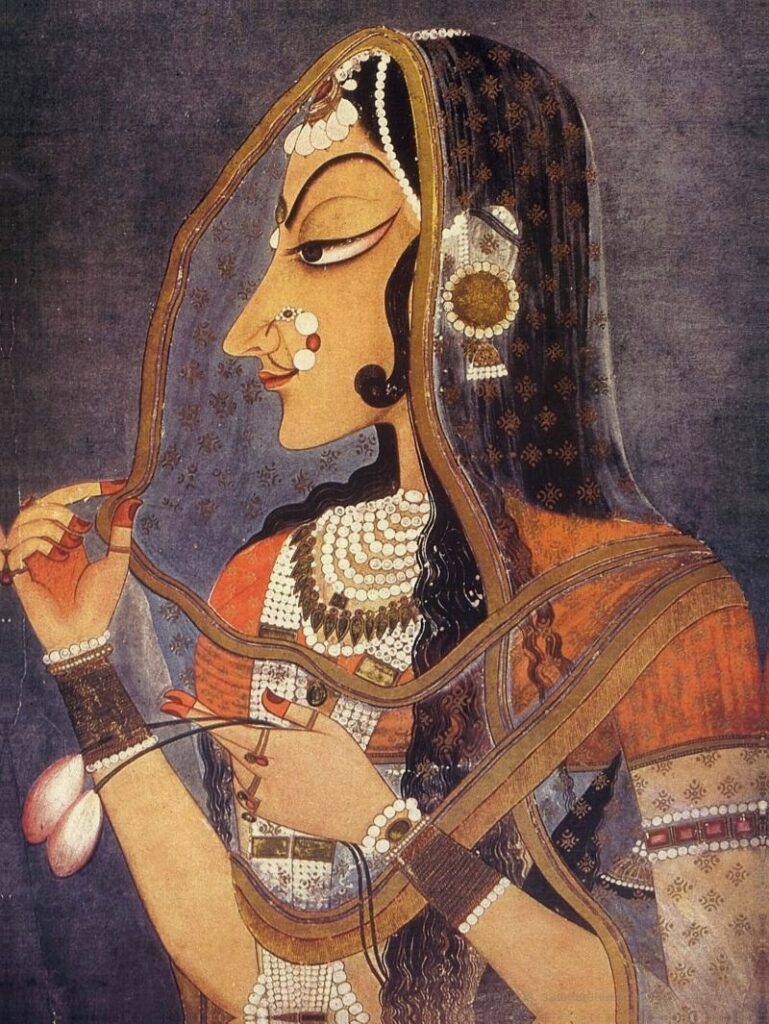
Bundi School of Painting
- The Bundi style of painting is very close to the Mewar style. It developed in Bundi and Kota. Painting in Bundi started as early as circa 1625 CE.
- One of the earliest examples of the Bundi Paintings is the Chunar Ragamala painted in 1561.
- Bundi and Kota’s kings were devotees of Krishna and in the 18th century, they declared themselves to be mere regents, ruling on behalf of the god who was the true king (similar patterns of worship are seen in several other centres, including Udaipur and Jaipur). Their Krishna-bhakti plays a role in painting or perhaps painting plays a role in their Krishna bhakti.
- Bundi paintings emphasized on hunting, court scenes, festivals, processions, life of nobles, lovers, animals, birds and scenes from Lord Krishna’s life. The Bundi school is characterized by a fondness for lush vegetation, dramatic night skies, a distinctive way of depicting water by light swirls against a dark background, and vivid movement.
- Human faces were round with pointed nose.
- Colour of sky is painted in different colours and mostly a red ribbon is visible in the sky.
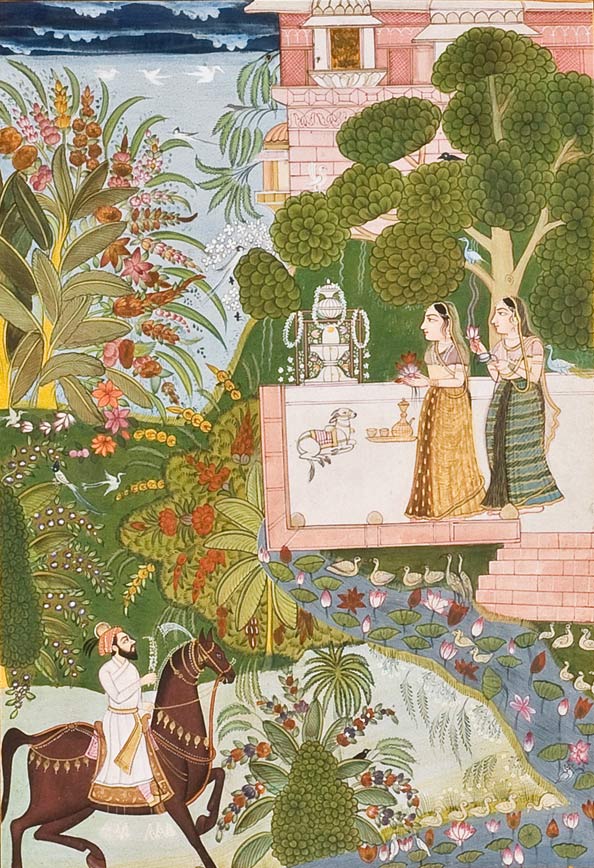
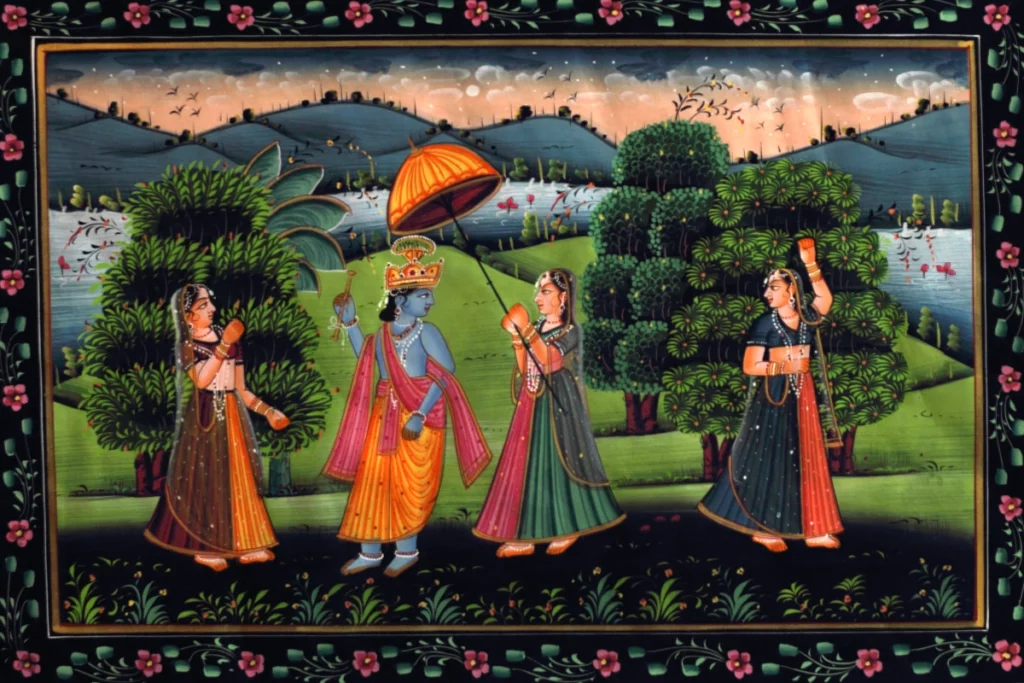
Amber-Jaipur School of Painting
- It was at Amber, the former capital city of Rajasthan, that the Jaipur School of paintings originated.
- The paintings of Amber style show strong Mughal influence. During the late 18th and early 19th centuries numerous works of art were produced that depicted episodes from the life of lord Krishna.
- The Amber school is also called the ‘Dhundar’ school and the earliest evidence of this school come from the wall painting at Bairat in Rajasthan.
- The Jaipur style of paintings excelled in life-size portraits, depiction of myths, ragas, astrological principles and different amusing and erotic themes. Jaipur style generally used a large size canvas, ornate backgrounds and bright gorgeous borders.
- In the paintings of the Jaipur style, men and women appear in proportion.
- Male figures have clean and attractive faces. Wealthy men are depicted wearing turban, kurta, pyjama, belt and shoes in such paintings.
- Female figures are depicted with large eyes, bunch of long hair, stout physique and pleasant mood.
- Lord Krishna and Radha, Rajput princes, fierce camel fights, Pomp and ceremony of the Mughal court, the Bhagwat Purana, the Ramayana and the Mahabharat are some of the favorite themes of Jaipur style.
- This school reached its pinnacle in the period of Sawai Pratap Singh in the 18th century. He was a deeply religious man and a passionate patron of art.
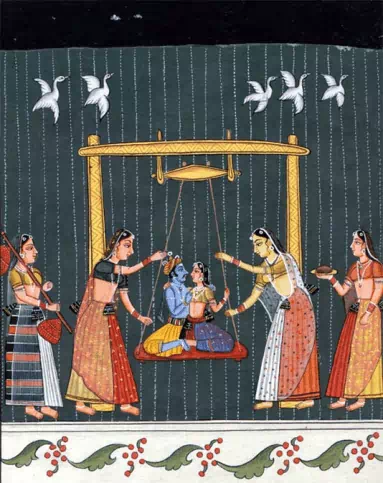
Marwar School of Painting
- It is one of the most extensive schools of painting as it includes Jodhpur and Bikaner, both ruled by the Rathods and Jaisalmer that was ruled by the Bhatis. Like Bikaner, Jodhpur too was a desert kingdom that prospered through its close links with the Mughals.
- In the paintings produced in the 15th and 16th century, the men wore colourful clothing and so did the women. In this period, they followed the Mughal patterns but after the 18th century, the Rajput element became predominant, for example, there was an influx of paintings that contained linear rhythm coupled with bright colours.
- The Jodhpur atelier has many brilliant paintings but the focus has always been on the extraordinary paintings in the time of Man Singh (1803-1843) and after. He commissioned extensive series of paintings including the Shiva Purana, Natacharitra, Durgacharitra, Panchtantra, etc.
- One of the earliest examples of painting in Marwar is a series of the Ragamala in the collection of Kumar Sangram Singh.
- Miniatures comprising portraits, court scenes, series of the Ragamala and the Baramasa, etc. were executed at several centres of painting like Pali, Jodhpur and Nagour etc. in Marwar.

Pahari School of Painting
- The Pahari region comprises the present State of Himachal Pradesh, some adjoining areas of the Punjab, the area of Jammu in the Jammu and Kashmir State and Garhwal in Uttarakhand.
- The whole of this area was divided into small States ruled by the Rajput princes. These States were centres of great artistic activity from the latter half of the 17th to nearly the middle of the 19th century.
- These consisted ateliers in the court of around 22 princely States stretching from Jammu to Almora. Hence, the Pahari paintings can be grouped into two major groups:
- Basholi School
- Kangra School
- The themes of the paintings ranged from mythology to literature and brought new techniques to the fore.
- A typical Pahari painting would bring several figures into the canvas and they would all be full of movement. Each figure is different in composition, colour and pigmentation.
- Three of the greatest painters of this school were Nainsukh, Manaku and Sansar Chand.
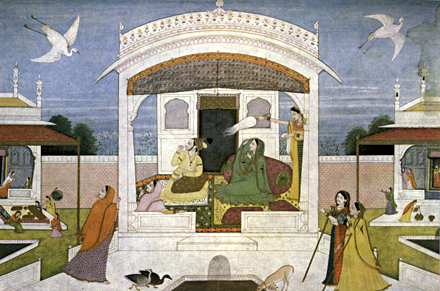
Basholi School
- Basholi was the arliest centre of painting in the Pahari region where miniatures of Rasamanjari series are found.
- This was the early phase and expressive faces with a receding hairline and big eyes that are shaped like lotus petals characterised it.
- The Basohli style of painting is characterised by vigorous and bold line and strong glowing colours. These paintings use a lot of primary colours, i.e. red, yellow and green.
- They used the Mughal technique of painting on clothing but developed their own styles and techniques.
- The Basohli style spread to the various neighbouring states and continued till the middle of the 18th century.
- The first patron of this school was Raja Kirpal Pal who ordered the illustration of Bhanudatta’s Rasamanjari, Gita Govinda and the Ramayana drawings.
- The most famous painter of this school was Devi Das who was famous for his depiction of Radha Krishna and the portrait of kings in their livery and in white garments.
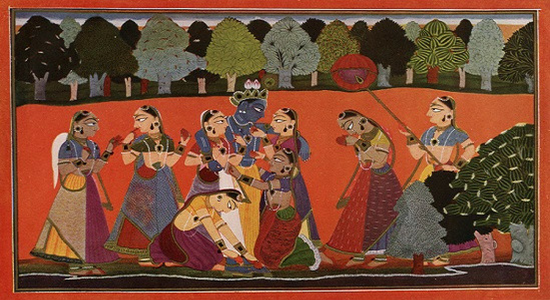
Guler School
- Guler school followed the last phase of the Basohli style.
- These paintings are in a new naturalistic and delicate style marking a change from the earlier traditions of the Basohli art. The colours used are soft and cool.
- The female figures in these paintings is particularly delicate with well-modelled faces, small and slightly upturned nose and the hair done minutely.
Kangra School
- After the decline of the Mughal empire, many artists trained in the Mughal style migrated to the Kangra region of Himachal Pradesh as they got patronage by Rajput Kingdom. It led to the birth of Guler-Kangra School of paintings. It first evolved in Guler then came to Kangra.
- This school reached its zenith under the patronage of Raja Sansar Chand. His paintings were marked with a sensuality and intelligence that the other schools lack.
- Kangra style followed the Guler style and it represents the third phase of the Pahari painting in the last quarter of the 18th century
- It possesses the main characteristics of the Guler style, like the delicacy of drawing and quality of naturalism.
- In these paintings, the faces of women in profile have the nose almost in line with the forehead, the eyes are long and narrow and the chin is sharp.
- The popular subjects were the Gita Govinda, Bhagwata Purana, Satsai of Biharilal and Nal Damayanti. Love scenes of Krishna was a very prominent theme. All the paintings had an other worldly feel about them.
- Another very famous group of paintings is the ‘Twelve months’ where the artist tried to bring forth the effect of the 12 months on the emotions of human beings. This emotive style was popular till the 19th century.
- The Kangra school became the parent school to the other ateliers which developed in the region of Kullu, Chamba and Mandi.
- In Kangra, Sansar Chand Museum can be visited to see the prominent Kangra school paintings.
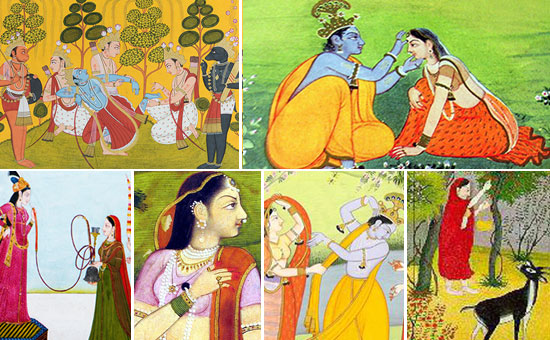
Kullu-Mandi School
- It is a folk style painting school the Kulu-Mandi area, mainly inspired by the local tradition.
- The style is marked by bold drawing and the use of dark and dull colours. Though influence of the Kangra style is observed in certain cases yet the style maintains its distinct folkish character. A large number of portraits of the Kulu and Mandi rulers and miniatures on other themes are available in this style.
Ragamala Paintings
- Ragamala Paintings are a series of illustrative paintings from medieval India based on Ragamala or the ‘Garland of Ragas’, depicting various Indian musical Ragas. They stand as a classical example of the amalgamation of art, poetry and classical music in medieval India.
- Ragamala paintings were created in most Indian schools of painting, starting in the 16th and 17th centuries and are today named accordingly, as Pahari Ragamala, Rajasthan or Rajput Ragamala, Deccan Ragamala, and Mughal Ragamala.
- In these paintings, each raga is personified by a colour describing the story of a hero and heroine (nayaka and nayika) in a particular mood. It also elucidates the season and the time of day and night in which a particular raga is to be sung.
- Moreover, many paintings also demarcate the specific Hindu deities attached with the raga, like Bhairava or Bhairavi to Shiva, Sri to Devi etc.
- The six principal ragas present in the Ragamala are Bhairava, Deepak, Sri, Malkaush, Megha and Hindola.
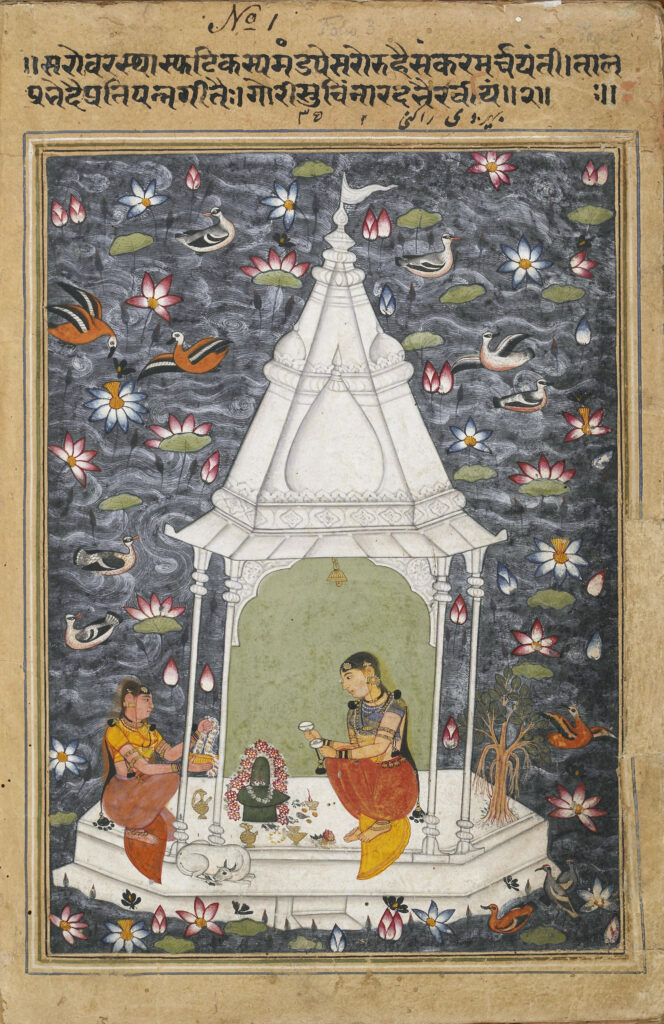
Comparison of Schools of Painting
| Mughal Paintings | Rajput Paintings |
|---|---|
| Aristocratic | Democratic |
| Realistic, Materialistic | Mystic, Spiritual |
| Secular | Religion is integral part |
| Confined of imperial courts, so mainly depicts the Mughal splendor and pomp. | It was art of the people, so had popular and familiar themes. |
| Isolated from Folk Art | Influenced by Folk Art |
| Many a times, deals with materialistic aspect of animal life such as hunting of deers, fighting of animals such as elephants. | Many a times deals with a the religious as well as aesthetic aspect of animal life, depicts animals as deities and also as increasing beauty in the paintings. |
Miniatures in South India
The trend of making miniature paintings was already prevalent in the South India and it developed in the early medieval period. These were different from the North Indian schools owing to the heavy use of gold in South Indian paintings. Furthermore, they concentrated on painting divine creatures much more than painting the rulers who patronised them. Some of the major schools are:
Tanjore Paintings (famous for gold coating)
- A style of painting characterised by bold drawing, techniques of shading and the use of pure and brilliant colours flourished at Tanjore in South India during the late 18th and 19th centuries.
- The paintings are notable for their adornment in the form of semi-precious stones, pearls, glass pieces and gold. The rich vibrant colors, dashes of gold, semi-precious stones and fine artistic work are characteristics of these paintings.
- The paintings are mostly of Gods and Goddesses because this art of painting flourished at a time when fine-looking and striking temples were being constructed by rulers of several dynasties.
- The figures in these paintings are large and the faces are round and divine. Most of the paintings depict smiling Krishna in various poses and various major events in his life.
- These paintings reached their zenith under the patronage of Maharaja Serfoji II of Maratha dynasty who was a great patron of art.
- Currently, this school is still operational but they have moved towards experimenting with diverse subjects like birds, animals, buildings, etc.
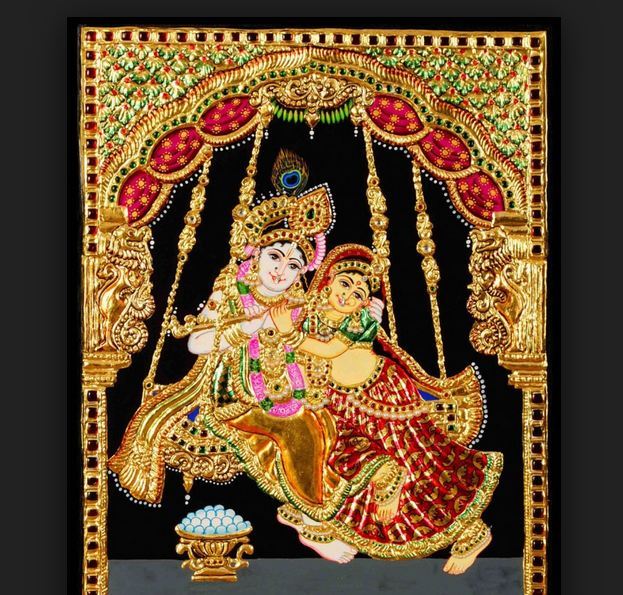
Mysore Paintings
- The distinct school of Mysore painting evolved from the paintings of Vijayanagar times during the reign of the Vijayanagar Kings (1336-1565 CE).
- Mysore paintings are known for their elegance, muted colours, and attention to detail. The themes for most of these paintings are Hindu gods and goddesses and scenes from Hindu mythology.
- The unique part of these paintings is that they had two or more figures in each painting and one figure predominates all the others in size and colour.
- Mysore Paintings are characterized by delicate lines, intricate brush strokes, graceful delineation of figures and the discreet use of bright vegetable colours and lustrous gold leaf.
- Gesso work was the hallmark of all traditional paintings of Karnataka. Gesso refers to the paste mixture of white lead powder, gambose and glue which is used as an embossing material and covered with gold foil. Gesso was used in Mysore painting for depicting intricate designs of clothes, jewellery and architectural details on pillars and arches that usually framed the deities.
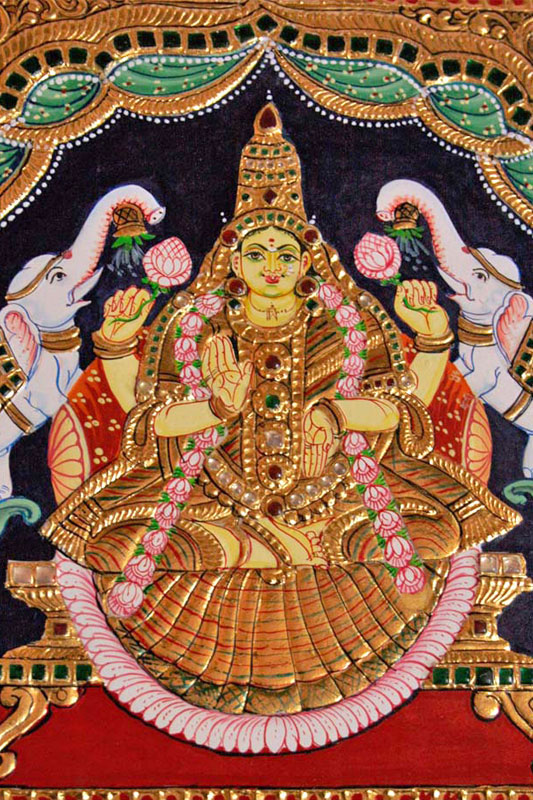
Modern Paintings
Company Paintings
- In the colonial period, a hybrid style of painting emerged that combined the elements of Rajput, Mughal and other Indian styles with European elements. These paintings evolved when the British Company officers employed painters who had been trained in Indian styles. Hence, they mixed their employer’s European tastes with their Indian training and were called the ‘Company Paintings’.
- They were distinguished by the use of water colour and in technique by the appearance of linear perspective and shading.
- This style of painting originated in Kolkata, Chennai, Delhi, Patna, Varanasi and Thanjavur.
- Mary Impey and Marquess Wellesley patronised large number of painters; several painters were engaged in painting the ‘exotic’ flora and fauna of India.
- The most famous of this school were Mazhar Ali Khan and Ghulam Ali Khan. These genre of paintings were prevalent till the 20th century.
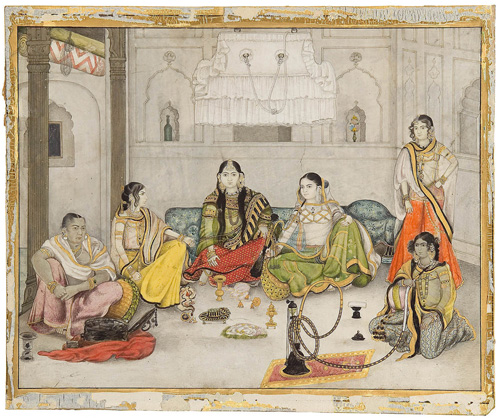
Bazaar Paintings
- This school was also influenced by the European encounter in India. They were different from the Company paintings as that school mixed European techniques and themes with Indian ones. The Bazaar school did not take any Indian influence but took the Roman and Greek influence. They made the painters to copy the Greek and Roman statues.
- This school was prevalent in Bengal and Bihar region. Apart from the Greco-roman heritage, they made paintings on everyday bazaar that showed Indian bazaars with European background.
- One of the most famous genres was depiction of Indian courtesans dancing before the British officials.
- They also painted religious themes but the figures of Indian Gods and Goddesses with more than two axes and elephant faces like that of Lord Ganesha were prohibited as they deviated from the European notion of natural human figurine.

Raja Ravi Verma
- Raja Ravi Verma is one of India’s greatest painters. He is considered to be the originator of the school of modern painting. The school was called ‘modern’ because of the heavy influence of western techniques and themes. He was unique as he brought together elements of South Indian painting with the Western techniques of colour and style.
- He belonged to the State of Kerala and is known as the ‘Father of Modern Indian Art’. Some of his extremely famous works include Ladies in the Moonlight, Shakuntala, Damayanti and Swan, etc.
- He gained nationwide recognition for his paintings from the epic Ramayana especially the one titled “Ravana kidnapping Sita and killing Jatayu”. A film has been made on him named “Rang Rasiya”.
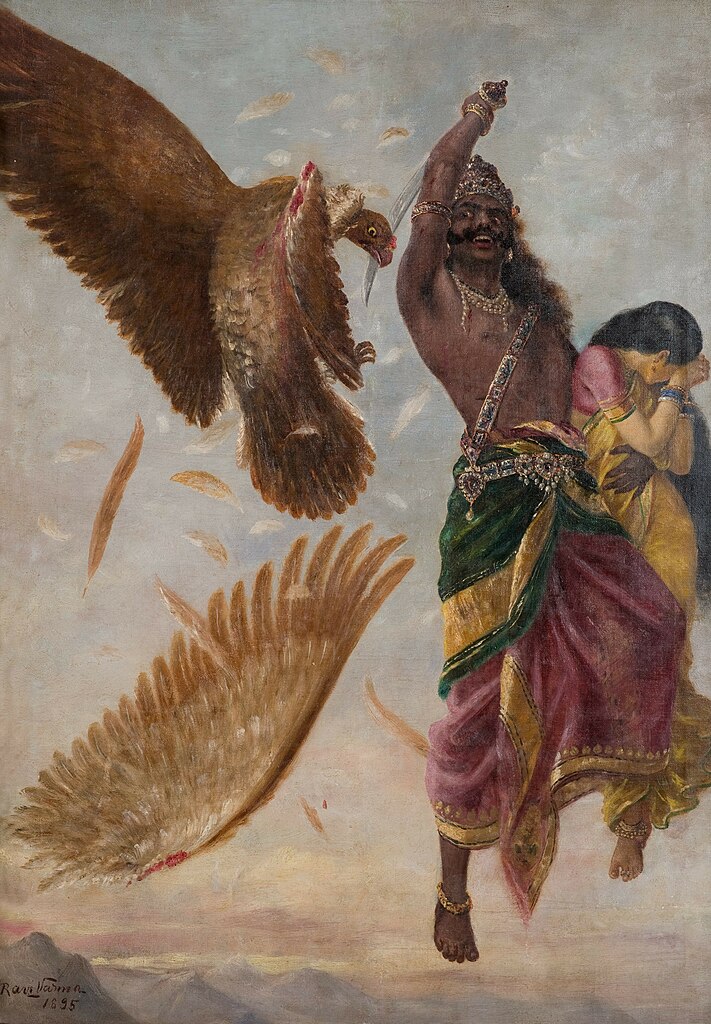
Bengal School of Art
- The Bengal school is supposed to have a reactionary approach to the existing styles of paintings. This school is unique as they use simple colours.
- The idea of the Bengal school came up with the works of Abanindranath Tagore in early 20th century. His Arabian night series made a mark on a global scale as it was path breaking from the previous schools of Indian painting and brought in something new. He tried to incorporate Swadeshi values in India art and tried to reduce the influence of Western materialistic style among artists. He is known for his painting Bharat Mata and various Mughal-themed paintings.
- The other notable painter of this school was Nandalal Bose whose works led to further development of Modern Indian Art. He was also associated with Santiniketan. He is known for his white-on-black Gandhi sketch of the Dandi March, which become iconic during 1930s. He was also entrusted with the task of illuminating the original document of the Constitution of India.
- Another most famous painter of this school was Rabindranath Tagore. His paintings were unique as they used dominant black lines that made the subject look prominent. He made small sized paintings. Some art historians argue that his paintings can be linked to his writings.
- Other famous painters of Bengal school are Asit Kumar Haldar, Manishi Dey, Mukul Dey, Sunayani Devi, etc.
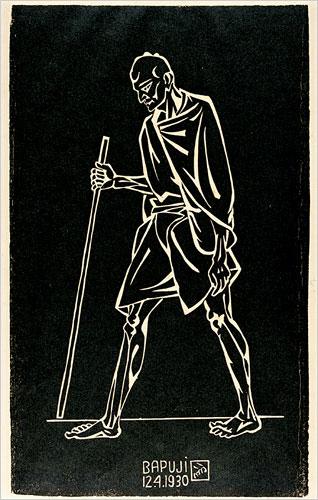

Cubist Style of Painting
- It took its inspiration from the European Cubist movement. Under this style, the objects were broken, analyzed and then reassembled. The artist reconstructed this process on the canvas through the use of abstract art forms. They tried to achieve perfect balance between line and color.
- Cubism was a truly revolutionary style of modern art developed by Pablo Picasso and Georges Braques.
- One of the most popular cubist artists in India was M.F Hussain. In the paintings that used abstract connotations, he used the motif of a horse frequently as it was best to depict the fluidity of motion.
